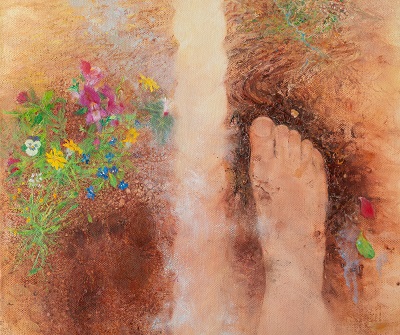Do/Not Covet
Thoughts on the painting Do/Not Covet, based on the exhibition text and gallery talk from the joint art project “Commandments and Commentary”, which was conceived, initiated and curated by Idit Levavi-Gabbai, and exhibited at Kupferman Collection House, Kibbutz Lohamei Hagetaot, 2022.

Do/Not Covet, 2021, oil on canvas, 40 X 170 cm (15.5″ X 67″).
A figure walks on a tightrope above boulders that open up to an abyss and overlook a dry mountainous landscape. In the figure’s hand is a note with the Biblical Hebrew words “Do not covet” (while the desert landscape echoes the place where this commandment was first spoken). The commandment guides us in our relationships with others, demanding that we don’t wish for what belongs to someone else. Thus we would expect the second figure in the painting, walking on the other end of the rope above yellow dunes (at the top of the vertical canvas), to portray that external other. Yet this figure is identical to the first, a reflection of her. She holds a counter command – because her thumb covers the single Hebrew word for “Do not”, we read “Covet.”
Do not covet – Covet
The competitive aspect of our economy, urging us to live in constant comparison with others, may take over our psyches, and it certainly hasn’t skipped over the art world. We are used to judging an artist’s success with quantitative tools: the number of exhibitions (and in what venues), the number of visitors to them, and of course, the prices of works sold. I, too, find myself enslaved by this way of thinking, such that I do not covet my neighbor’s ox or donkey (or the modern equivalent, his car; nor his wife), but rather his or her art prize or museum show. At the same time, I rebel against this quantitative assessment: are a thousand visitors passing by a painting worth more than one standing opposite it, moved to tears?
I take the prohibition against coveting seriously and attempt to live according to it; at the same time, I recognize my desires and ambitions. I hear a voice saying “desire, want” or at least admit how much you do.
What is going on at the center of the tightrope? I invite you to stop reading and look again at thus part of the painting. Here is my interpretation: If the painting offers a way out for the figure caught between the ends of the tightrope, between “Do not covet” and “Covet”, it is not one of tranquility, of detachment from desires. Instead, the figure steps down from the rope and onto the ground, to be present and involved in the world, to step barefoot into the mud and into the paint. Only from that messy ground will growth be possible, will a garden begin to flourish.

Do/Not Covet, detail
Afterward: The painting Do/Not Covet generated new work, forming a trilogy and touching on the connection between coveting and the land, and asking if the tightrope, which may be a zero-sum game when two people try to walk on it, can become a path.

Rope or Path? Triptych Right: Do/Not Covet, 2021, oil on canvas, 170×40 cm (67″x15.5″) Center: Eretz Hemda (A Desirable Land), 2023, oil on canvas, 175×45 cm (69″x17.5″) Left: Path, 2022, oil on canvas, 180×50 cm (71″x19.5″)
Photography: Yigal Pardo